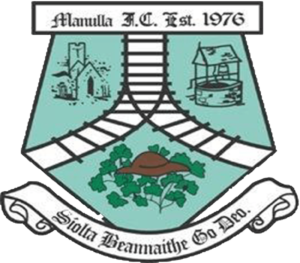Crest History

The crest that adorns the Manulla jersey tells a story in itself. Several stories in fact, of ancient times in a village that has progressed through the ages from Pagan tradition, to the coming of Christianity, to the onset of our own special form of industrialisation. Manulla is a place that is steeped in folklore and those historic tales live on today, not only in the fables of local scholars, but also in the crest which the soccer club chose for itself when it was established in 1976. The founders of the club decided to create a crest that drew largely on the most interesting and significant happenings in the history of Manulla. For this, they designed a crest based on the physical ruins that are still dotted throughout the village today, and chose a motto that came from the words of St Patrick himself. A special thanks must go to Jackie Clarke who designed the Club Crest.
Castle: The castle on the top left-hand corner of the crest is symbolic of the ancient castle once owned and inhabited by Walter McEvilly at the time of the division of Connaught. The McEvillys were a family who derived their name from the Stauntons, closely related to Granuaile. The ruins of this castle are still to be seen on the property of Jimmy Staunton, Manulla
Well: On the top right-hand corner, the well depicts the ancient "Well of Findmagh". This well was once the centre of Druid worship in the region, because the Druids believed that a certain dead prophet had made a coffin for himself under the stone which covered the well so that the "waters might wash his bones because he feared the fire". It was here at this well that St Patrick converted the Pagans to Christianity. After Patrick's visit, the old name for Manulla - Findmagh - changed to "Slanpatrick" and the "Well of Slan". The remnants of this well can still be seen close by the castle ruins mentioned above
Shamrock & hat: The shamrock has its association with St Patrick's visit to Manulla. Cradled among the shamrock is a hat. The symbolism attached to the hat relates to an old 'cottage-type' industry that existed in Manulla many years ago. The people made hats in their homes and sold them to supplement their meagre incomes. Hence the expression "the Manulla Hatters"
Railway Junction: The Railway Junction is synonymous with Manulla. It was built around the 1860's with the arrival of the railway to the West of Ireland. The junction at Manulla was closed for a spell in the 1950's, much to the disappointment of more senior locals who still hold memories of the bustling and busy station it once was. At present, the junction is only used as a transfer point, where rail travellers from Foxford and Ballina join the main train from Westport to Dublin.
Shades of Green: The crest is placed against a background of various shades of green to symbolise the ancient name of the village, "Findmagh", meaning"Fair Plain".
Club motto: "Siolta Beannaithe go Deo" - these were the words spoken by St Patrick to Cainnech at the "Well of Findmagh". Patrick baptised Cainnech there, appointed him as the leader of the new Christian community in Manulla and promised him "Thy seed will be Blessed forever".

